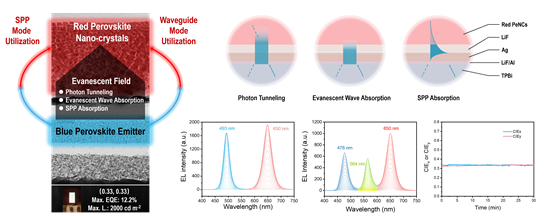Recently, Prof. Hin-lap Yip’s group (in State Key Laboratory of Luminescent Materials and Devices, South China University of Technology) has published a research article in Joule, with the title of ‘Utilization of Trapped Optical Modes for White Perovskite Light-Emitting Diodes with Efficiency over 12%.
White light-emitting diodes (LEDs) are the important components in lighting and display applications, which consume a large portion of energy in our daily life; therefore, an efficient white LED is important for energy saving and carbon footprint reduction. Metal-halide perovskite LEDs (PeLEDs) show great potential to be the next-generation lighting technology, with external quantum efficiencies (EQEs) improved from less than 1% to more than 20% for red and green LEDs and more than 12% for blue LEDs. However, the development of white PeLEDs remains a great challenge at this stage. Besides, the inferior light extraction efficiency (LEE) of PeLEDs, which is generally less than 20%, based on optical modelling, becomes another main issue limiting their further development.
To address the aforementioned issues, Yip’s group reported a simple but efficient approach to construct high-performance white PeLEDs with much-enhanced LEE by coupling a blue PeLED with a layer of red perovskite nanocrystal (PeNC) down-converter through a rationally designed multilayer semitransparent electrode (LiF/Al/Ag/LiF).
In PeLEDs, the large refractive index difference between perovskite and organic interfacial materials can induce the total internal reflection which leads to a waveguide mode that severely traps photons within the device. Fortunately, when photons propagate to the metal electrode and are in the internal total reflection condition, an evanescent wave is generated and its energy penetrates to the adjacent layer in the near field, which becomes an opportunity to utilize the evanescent wave and hence suppress the waveguide mode. In addition, the evanescent wave can also induce the SPP mode, which energy also penetrates to the adjacent layer in the near field and hence can be utilized.
To meet this end, Yip’s group developed a semi-transparent blue PeLED with a device structure of ITO/NiOx/PVK/sky-blue perovskite/TPBi/LiF/Al/Ag/LiF. When depositing a red perovskite layer above its ultra-thin metal electrode, ensuring the existence of this layer within the penetration depths of evanescent wave and SPP, three near-field effects occur (i.e. photon tunnelling, evanescent wave absorption, and SPP absorption). Consequently, this device design provides three channels for the trapped blue photons to escape from the emissive layer and hence suppress the waveguide and SPP modes simultaneously, resulting in a 50% LEE improvement. Moreover, combining the blue photons and the down-converted red photons, highly efficient white PeLEDs with EQE exceeding 12% are successfully demonstrated. This state-of-the-art result makes the work become a milestone in the PeLED field. Besides, this strategy could also be extended to other types of white LEDs, such as inorganic, quantum dot, and hybrid LEDs, etc., to improve their light extraction in chips, which broadly contributes to the field of energy-saving lighting devices.

The concept of white PeLED design and the schematic diagram of three near-field effects of photon tunneling, evanescent wave absorption, and SPP absorption. And the electroluminescent spectra of two-color and three-color white PeLEDs, as well as its CIE change under operating.
Authors: Ziming Chen, Zhenchao Li, Zhen Chen, Ruoxi Xia, Guangruixing Zou, Linghao Chu, Shi-Jian Su, Junbiao Peng, Hin-Lap Yip, Yong Cao.
Corresponding Authors: Ziming Chen and Hin-Lap Yip
This study was financially supported by the Guangdong Major Project of Basic and Applied Basic Research, the National Natural Science Foundation of China, and the China Postdoctoral Science Foundation.
Ziming Chen*, Zhenchao Li, Zhen Chen, Ruoxi Xia, Guangruixing Zou, Linghao Chu, Shi-Jian Su, Junbiao Peng, Hin-Lap Yip* and Yong Cao, Joule, 2021, 5, 456-466.
https://www.sciencedirect.com/science/article/abs/pii/S2542435120306073
Introduction of corresponding authors:
Prof. Hin-Lap Yip focuses his research on optoelectronic devices based on perovskite and organic materials. He is also interested in exploiting new applications and technology commercialization. He has had over 200 peer-reviewed papers published in high-impact journals, including Nature, Science, Nature Photonics, Joule, Nature Communications, Advanced Materials, etc. (>25,000 citations, h-index 80), and has been selected as a highly cited researcher (Clarivate Analytics, 2014-2020). He is also the associate editor of Science Bulletin, Journal of Semiconductors, and is an international advisory board member of Matter.
Dr. Ziming Chen focuses his research on perovskite optoelectronic device, particularly light-emitting diodes and solar cells. More specifically, his research includes optoelectronic properties and nanostructure analysis of perovskite films, device design and engineering, photophysics and device physics studies, etc. He had published 21 scientific papers including Joule, Reports on Progress in Physics, Nature Communications, iScience, Advanced Materials, with citations of around 1400 and an H-index of 15. One of his publications is selected as ‘Top 100 most influential papers in China (2019)’.





